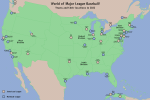I may or may not have attempted to start a full timeline here a few months ago, lost motivation immediately, and just picked it back up as a one-off. Anyway here you go, I'll make a write-up of the lore later.
Base map courtesy of the Pergamon World Atlas.
Presidents and Congresses of the Confederate States of America
On February 8, 1861, the Confederate States of America was established via the Montgomery Convention between the slave states of Alabama, Florida, Georgia, Louisiana, Mississippi, and South Carolina after they declared secession from the United States of America in protest of the election of anti-slavery President Abraham Lincoln the previous year. Over the following months the states of Arkansas, North Carolina, Tennessee, Texas, and Virginia also declared secession from the United States and joined the Confederacy. Most Native American tribes in the Indian Territory also signed treaties of friendship with the Confederacy during this period. The United States did not initially recognize the Confederacy and attempted to militarily recapture it during the 1861-1863 War of Secession but was ultimately forced to recognize its independence under foreign pressure following a series of military defeats. On February 9, 1863, the United States made formal peace with the Confederacy via the British-mediated Treaty of London. The states of Kentucky and Missouri were also claimed by the Confederacy and represented in its Congress during the War of Secession but were never de facto controlled by the Confederacy and were retroceded to the United States in the Treaty of London, alongside the western counties of Virginia as the new state of West Virginia. The Confederacy also claimed parts of the New Mexico Territory (later divided between the New Mexico Territory and the unrelated United States Arizona Territory) as the Confederate Arizona Territory during the War of Secession but retroceded it to the United States in the Treaty of London.
NOTE: Due to the de jure nonpartisan nature of the Confederacy its political officers did not carry official party affiliations. Despite this the Confederacy became de facto divided between two major political factions over time, eventually resulting in the Confederate Civil War. These factions are most often referred to as "Centralists" and "anti-Centralists" in retrospect but were known by a variety of names in their original time depending on context. For this list the names "pro-administration" and "anti-administration" are used for these factions during the War of Secession and Jefferson Davis administration then "Centralist" and "anti-Centralist" afterwards.
Provisional Government of the Confederate States of America (1861-1862)
1861-1862: Provisional President
Jefferson Davis (
pro-administration, Mississippi) / Acting Vice President
Alexander H. Stephens (
anti-administration, Georgia)
(1861 def. Senator Robert Toombs (anti-administration, Georgia) via convention)
- 1861-1862 Provisional Congress
- (Unicameral): pro-administration majority
On February 22, 1862, the Provisional Constitution of the Confederate States was superseded by the permanent Constitution of the Confederate States which was ratified the previous year.
Confederate States of America (1862-1881)
1862-1868: President
Jefferson Davis (
pro-administration, Mississippi) / Vice President
Alexander H. Stephens (
anti-administration, Georgia)
(1861 unopposed)
- 1862-1864 Congress
- Senate: pro-administration majority
- House: pro-administration majority
- 1864-1866 Congress
- Senate: pro-administration majority
- House: pro-administration majority
- 1866-1868 Congress
- Senate: anti-administration majority
- House: anti-administration majority
1868-1874: President
Joseph E. Brown (
anti-Centralist, Georgia) / Vice President
Robert M. T. Hunter (
anti-Centralist, Virginia)
(1867 def. Speaker of the House Thomas S. Bocock (Centralist, Virginia) / Senator Clement C. Clay Jr. (Centralist, Alabama))
- 1868-1870 Congress
- Senate: anti-Centralist majority
- House: anti-Centralist majority
- 1870-1872 Congress
- Senate: anti-Centralist majority
- House: anti-Centralist majority
- 1872-1874 Congress
- Senate: anti-Centralist majority
- House: Centralist majority
1874-1880: President
Clement C. Clay Jr. (
Centralist, Alabama) / Vice President
Zebulon B. Vance (
Centralist, North Carolina)
(1873 def. Vice President Robert M. T. Hunter (anti-Centralist, Virginia) / Senator Robert W. Barnwell (anti-Centralist, South Carolina))
- 1874-1876 Congress
- Senate: Centralist majority
- House: Centralist majority
- 1876-1878 Congress
- Senate: anti-Centralist majority
- House: Centralist majority
- 1878-1880 Congress
- Senate: anti-Centralist majority
- House: anti-Centralist majority
1880-1884: President
Wade Hampton III (
Centralist, South Carolina) / Vice President
James L. Kemper (
Centralist, Virginia)
(1879 def. Governor John McEnery (anti-Centralist, Louisiana) / Senator Isham G. Harris (anti-Centralist, Tennessee))
- 1880-1882 Congress
- Senate: anti-Centralist majority elected, Centralist majority following the 1881 resignation of most anti-Centralist senators in favor of the Atlanta Convention
- House: anti-Centralist majority elected, Centralist majority following the 1881 resignation of most anti-Centralist representatives in favor of the Atlanta Convention
Following the Depression of 1880-1881 and the Black Spring of 1881 President Wade Hampton III issued the Electoral Security Resolution on April 22, 1881, which declared that the midterm elections of 1881 would not be held as scheduled and instead be delayed until “civic order may be completely restored in the Confederate States” and that Congress would then be recessed after the scheduled end of the 1880-1882 congressional term. The state governments of Alabama, Florida, Georgia, Louisiana, Mississippi, and South Carolina subsequently declared this action legally invalid, began an interstate convention in Atlanta, Georgia, and then issued the Atlanta Declaration on May 9, 1881, which declared that the Electoral Security Resolution must be rescinded before the scheduled end of the midterm elections on November 6, 1881, or else they would begin an armed rebellion. The state government of Texas also issued a resolution which declared that it would enforce a policy of “armed neutrality” in any interstate conflict until the “legitimate government of the Confederate States may be ascertained” on June 3, 1881. Most counties in southern and central Florida disregarded the state government’s adherence to the Atlanta Declaration and formed a rival state government based in Tampa. In the following weeks most anti-Centralist Confederate government officers resigned and declared loyalty to the Atlanta Convention. Following the passage of the midterm elections’ scheduled end date armed conflict began between the existing Confederate government, retrospectively referred to as the “Richmond Government”, and the Atlanta Convention, retrospectively referred to as the “Atlanta Government”.
Richmond Government of the Confederate States of America (1881-1884)
1880-1884: President
Wade Hampton III (
Centralist, South Carolina) / Vice President
James L. Kemper (
Centralist, Virginia)
(1879 def. Governor John McEnery (anti-Centralist, Louisiana) / Senator Isham G. Harris (anti-Centralist, Tennessee))
- 1880-1882 Congress
- Senate: anti-Centralist majority elected, Centralist majority following the 1881 resignation of most anti-Centralist senators in favor of the Atlanta Convention
- House: anti-Centralist majority elected, Centralist majority following the 1881 resignation of most anti-Centralist representatives in favor of the Atlanta Convention
- (Indefinitely recessed following the expiration of the 1880-1882 congressional term)
On July 15, 1884, the Richmond Government of the Confederate States of America was dissolved following the Confederate Instrument of Surrender at Raleigh and its remaining legal and financial obligations were assumed by the United States of America, which subsequently reorganized much of the Upper South into a series of federally controlled military districts. These military districts were eventually divided and readmitted to the United States as states.
Atlanta Government of the Confederate States of America (1881-1885)
1881-1885: Provisional President
John McEnery (
anti-Centralist, Louisiana) / Acting Vice President
Benjamin R. Tillman Jr. (
anti-Centralist, South Carolina)
(1881 def. Senator Isham G. Harris (anti-Centralist, Tennessee) via convention)
- 1881-1885 Provisional Congress
- Senate: anti-Centralist majority
- House: anti-Centralist majority
On April 5, 1885, the city of Atlanta, Georgia and its defenders surrendered to the United States Army, which arrested most Atlanta Government political officers including Acting Vice President Benjamin R. Tillman Jr., after Provisional President John McEnery was mistakenly killed by friendly soldiers while attempting to flee the city. At this point the Atlanta Government of the Confederate States of America effectively ceased to exist and this date is generally regarded as the end of the Confederacy’s existence for historical purposes, but major armed groups claiming to represent the Confederate government continued to operate in the former Confederacy until late 1890. Following the dissolution of the Confederacy most of its former territory was divided between the United States of America and the Free Republic of Libertalia, an abolitionist state in the Deep South created by former slaves who revolted against the Confederacy during the Confederate Civil War. Numerous smaller states also came to exist on the fringes of the former Confederacy through various means during this period.








